Sweet Corn
Attention sweet corn growers! Please take a few moments to complete this survey. Rutgers IPM personnel expect to participate in grant funded research guided by grower responses. See the brief description below. Thank you for your help!
Corn Earworm Management in Sweet Corn Needs Assessment Survey
Dr. Kelly Hamby, Associate Professor/Extension Specialist with the Department of Entomology at University of Maryland, is leading a team of researchers, including Rutgers IPM staff, who have developed a survey to prioritize research and extension efforts for improving corn earworm management in sweet corn throughout the Northeast. We appreciate your participation in this survey and will use results to develop a grant proposal to try to get federal funding to address these needs.
Survey link: https://ume.qualtrics.com/jfe/form/SV_9vRh1xHnDp4KEaa
Low numbers of European corn borer (ECB) moths continue to be captured in parts of the state. Cool temperatures over the past weekend have likely suppressed activity, and warmer weather in the upcoming week may trigger a modest rebound. The highest adult activity is currently around the Atlantic-Camden County border (see map at right). Whorl corn is the primary target for egg laying, and injury as high as 16% of plants infested has been found up to northern Monmouth County this week. Feeding levels should rise over the next 3 weeks.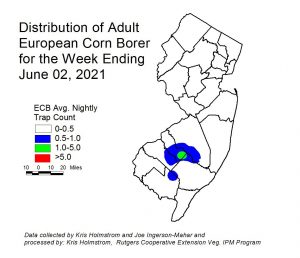
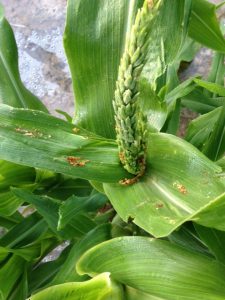 Look for the characteristic “shot-hole” type of feeding (photo below at right) and consider treating when infested plants exceed 12% in a 50 plant sample. As plantings proceed to the pre-tassel stage, ECB larvae may be found in emerging tassels (see photo at left). It is a good idea to treat individual plantings as they move into the full tassel/first silk stage one time. This eliminates any ECB larvae that have emerged with the tassels as they begin to move down the stalk to re-enter near developing ears.
Look for the characteristic “shot-hole” type of feeding (photo below at right) and consider treating when infested plants exceed 12% in a 50 plant sample. As plantings proceed to the pre-tassel stage, ECB larvae may be found in emerging tassels (see photo at left). It is a good idea to treat individual plantings as they move into the full tassel/first silk stage one time. This eliminates any ECB larvae that have emerged with the tassels as they begin to move down the stalk to re-enter near developing ears.
Useful insecticides for this particular application include synthetic 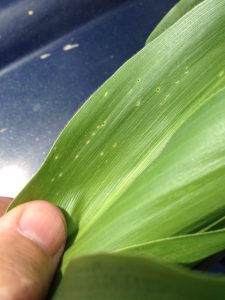 pyrethroids (IRAC Grp 3), spinosyns (including OMRI approved Entrust) IRAC Grp 5), and diamides such as Coragen or Vantacor (IRAC Grp 28) or materials such as Besiege which include the active ingredient in Coragen. Synthetic pyrethroids alone should NOT be used for corn earworm (CEW) protection on silking corn. Control with these materials is very inconsistent.
pyrethroids (IRAC Grp 3), spinosyns (including OMRI approved Entrust) IRAC Grp 5), and diamides such as Coragen or Vantacor (IRAC Grp 28) or materials such as Besiege which include the active ingredient in Coragen. Synthetic pyrethroids alone should NOT be used for corn earworm (CEW) protection on silking corn. Control with these materials is very inconsistent.
The highest nightly trap catches of ECB for the week ending 6/02/21 are as follows:
| Elm 2 | Denville 1 | Pedricktown 1 |
| Asbury 1 | Medford 1 | Sergeantsville 1 |
| Clinton 1 | Milford 1 | Tabernacle 1 |
| Dayton 1 | New Egypt 1 | Woodstown 1 |
Only two corn earworm (CEW) moths were captured in blacklight traps this past week (Centerton and New Egypt). However, the single pheromone trap that has been deployed thus far, near Monroeville, Salem County, captured 16 moths per night over the weekend. This one catch indicates that a low but economically significant population is presently active in the southwestern counties. The earliest plantings, now in silk, are at risk of CEW infestation. Be sure to access information from this publication in the upcoming weeks to determine how frequently you must treat silking sweet corn to protect it from CEW infestation.
The highest nightly blacklight trap catches of CEW for the week ending 6/02/21 are as follows:
| Centerton 1 |
| New Egypt 1 |
The highest nightly pheromone trap catches of CEW for the week ending 6/02/21 are as follows:
Monroeville 16
At the present time, growers in the southern counties who have silking sweet corn, should consider a 4-day spray schedule to prevent ear infestations. This situation is likely temporary, and we hope to provide more definition regarding the extent of this population as more traps are deployed over the coming week.
Cole Crops
Low numbers of imported cabbage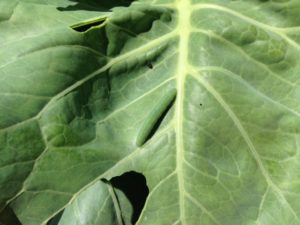 worm (ICW at left) continue in cole crop plantings everywhere. With warmer temperatures on the way, these infestations should increase rapidly and continue for the duration of the growing season. Check 5 consecutive plants each in 10 random locations throughout the planting, paying particular attention to the innermost leaves where ICW often feed (see photo at lower right). Consider treating if caterpillars are found on 10% or more plants that are in the 0-9 true leaf stage. From 9-leaf to the early head stage (in broccoli, cauliflower, and cabbage) infestations up to 20% may be tolerated. Once heads begin to form, a 5% threshold should be observed to protect the marketable portion of
worm (ICW at left) continue in cole crop plantings everywhere. With warmer temperatures on the way, these infestations should increase rapidly and continue for the duration of the growing season. Check 5 consecutive plants each in 10 random locations throughout the planting, paying particular attention to the innermost leaves where ICW often feed (see photo at lower right). Consider treating if caterpillars are found on 10% or more plants that are in the 0-9 true leaf stage. From 9-leaf to the early head stage (in broccoli, cauliflower, and cabbage) infestations up to 20% may be tolerated. Once heads begin to form, a 5% threshold should be observed to protect the marketable portion of 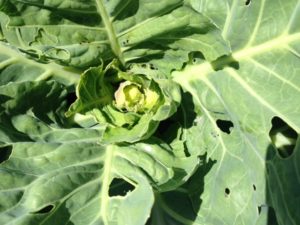 the plant. For leafy greens such as collards and kale, 10% plants infested is the threshold throughout.
the plant. For leafy greens such as collards and kale, 10% plants infested is the threshold throughout.
Diamondback moth larvae (DBM) are now the dominant pest in a number of scouted plantings. Remember that some populations of DBM are resistant to carbamate and synthetic pyrethroid insecticides. The lack of DBM control with these insecticides has been noted in NJ previously. It is important to distinguish between common cole crop pests for this reason. DBM larvae grow to a length of approximately 0.5”, and taper toward both ends (see photo at lower right).  These caterpillars thrash violently when disturbed. ICW grow to a length of approximately 1.25” and are covered with short hairs. Some chemistries that specifically target caterpillar pests are effective against DBM as well as all other caterpillar pests of cole crops. These materials include (active ingredient – trade name (IRAC* code)):
These caterpillars thrash violently when disturbed. ICW grow to a length of approximately 1.25” and are covered with short hairs. Some chemistries that specifically target caterpillar pests are effective against DBM as well as all other caterpillar pests of cole crops. These materials include (active ingredient – trade name (IRAC* code)):
Spinosad/Spinetoram – Entrust/ Radiant (5)
Chlorantraniliprole – Coragen (28)
Cyantraniliprole – Exirel (28)
The IRAC group 5 insecticide, Entrust, is OMRI approved for organic production. Insecticides based on the soil-inhabiting bacterium Bacilllus thuringiensis (B.t.) may also be effective on caterpillar pests of cole crops. Examples include Xentari and Javelin.
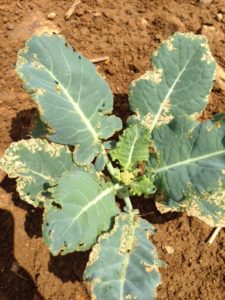 Flea beetles remain very active in a number of plantings, and warmer days will accelerate injury. Signs of “shot-hole” in leaves of host crops are an indication that flea beetles are present, even if the pests are not visible due to cold/wet weather. These pests have a preference for the “hotter” flavored crops like arugula, mustard greens, and turnip greens. They also attack Tuscan or lacinato kale frequently. Plants may be protected with at-planting, soil-applied neo-nicotinoid insecticides (see the 2020/21 Commercial Vegetable Production Recommendations for products). An OMRI approved foliar material for flea beetle management is Pyganic. This product will provide knock-down of flea beetles, but may need to be applied frequently on preferred host crops.
Flea beetles remain very active in a number of plantings, and warmer days will accelerate injury. Signs of “shot-hole” in leaves of host crops are an indication that flea beetles are present, even if the pests are not visible due to cold/wet weather. These pests have a preference for the “hotter” flavored crops like arugula, mustard greens, and turnip greens. They also attack Tuscan or lacinato kale frequently. Plants may be protected with at-planting, soil-applied neo-nicotinoid insecticides (see the 2020/21 Commercial Vegetable Production Recommendations for products). An OMRI approved foliar material for flea beetle management is Pyganic. This product will provide knock-down of flea beetles, but may need to be applied frequently on preferred host crops.
Tomatoes
Field scouting of outdoor and high tunnel tomatoes has begun. Low level aphid populations (see photo at right) continue in a number of recently transplanted fields. With plants in the vegetative or early flower stages, it is often acceptable to allow natural predation and parasitism to take its course. Beneficial insects such as syrphid fly maggots, ladybird beetles and parasitic wasps will frequently limit the advance of these early aphid populations before the advent of fruit production. This is particularly true if broad spectrum insecticides are avoided at this time. If aphid populations persist into the early/enlarging fruit stage, and their droppings are accumulating on fruit, aphid specific insecticides may be advisable. 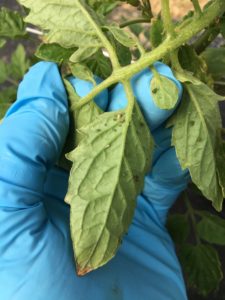 Growers should check tomatoes at least weekly, and note the presence of spider mites or aphids. Mites in particular should be treated early, so that they do not build to a population that becomes difficult to manage. Consider treating if aphids are found on multiple sites in a 5-site sample, and fruit are beginning to develop.
Growers should check tomatoes at least weekly, and note the presence of spider mites or aphids. Mites in particular should be treated early, so that they do not build to a population that becomes difficult to manage. Consider treating if aphids are found on multiple sites in a 5-site sample, and fruit are beginning to develop.
Peppers
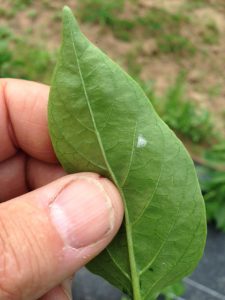 With ECB moth activity now present, growers should be looking for ECB egg masses (see photo at left) on the underside of pepper leaves. The larvae that hatch from these eggs will bore into the central stem of pepper plants in the absence of suitable fruit. This damage causes the tops of the plant to die, and eliminating the crown set of fruit in the process. Check 2 leaves per plant on 5 consecutive plants in 10 random locations. Consider treating if 2 or more leaves are found to have ECB larvae on the lower surface.
With ECB moth activity now present, growers should be looking for ECB egg masses (see photo at left) on the underside of pepper leaves. The larvae that hatch from these eggs will bore into the central stem of pepper plants in the absence of suitable fruit. This damage causes the tops of the plant to die, and eliminating the crown set of fruit in the process. Check 2 leaves per plant on 5 consecutive plants in 10 random locations. Consider treating if 2 or more leaves are found to have ECB larvae on the lower surface.
Pepper weevil – Pheromone traps continue to be set out across southern New Jersey. As yet, no weevils have been trapped. Weevils escaping from processing facilities could be present as soon as transplanting is finished. A new fact sheet is now available for anyone interested in monitoring for pepper weevils on their own: FS1330: Monitoring and Management of Pepper Weevil in New Jersey (Rutgers NJAES).

